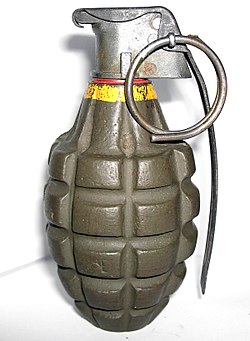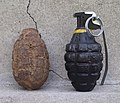Mk 2 grenade
This article includes a list of general references, but it lacks sufficient corresponding inline citations. (April 2009) |
| Mk 2 Grenade | |
|---|---|
 World War II–era Mk 2 grenade | |
| Type | Time-fused grenade |
| Place of origin | United States |
| Service history | |
| In service | 1918–1969 |
| Used by | See Users |
| Wars |
|
| Production history | |
| Designed | 1918 |
| Produced | 1918–1950s |
| Specifications | |
| Mass | About 1 lb 5 oz (600 g) depending upon filling |
| Length | 3.5 inches (89 mm) body 4.5 inches (110 mm) overall |
| Diameter | 2.3 inches (58 mm) |
| Filling | Varied |
| Filling weight | Varied |
Detonation mechanism | percussion cap & time fuse: 4–5 second delay |
The Mk 2 grenade (initially known as the Mk II), also nicknamed the Pineapple is a
The Mk 2 was gradually phased out of service as the M26-series (M26/M61/M57) grenade was introduced during the Korean War. Due to the tremendous quantity manufactured during World War II the Mk 2 was still in limited issue with the US Army and US Marine Corps throughout the 1950s and 1960s. The U.S. Navy was one of the last users of the Mk 2 when it was finally withdrawn from U.S. military service in 1969, replaced with the M33 series (M33/M67).
Description
This section needs additional citations for verification. (March 2024) |
The Mk 2 grenade did not widely replace the failed Mk 1 grenade used by the U.S. military during World War I. Although 44 million were ordered and more than 21 million were completed (it was possible to convert Mk 1 grenade bodies to the Mk 2 configuration) before the war ended, few reached American troops overseas. It was formally standardized in 1920. The Mk 2, like the Mk 1, was manufactured of
The version of the MK2 in use around 1969, weighted 595 grams, had 57 grams of flaked TNT, and can be thrown at least 30 m (98). A 10 meter "effective causality" distance is listed, but this is likely a typo.[3] It can be presumed that since it has similar weight and TNT amount to the F1 grenade, it might have very similar throwing and fragmentation distances.
Fuses
The Mk 2 used the M5, M6, M10, M11, or M204 series fuses. The early M5, and the later M6 and M204 series detonating fuses, were used on high explosive-filled grenades. The M10 and M11 series igniting fuses were used on low explosive-filled ones. The early fuses had many problems. In the M5, moisture could get in under the foil fuse cap, causing the weapon to fail to detonate. The early fuses were not completely silent and made a loud "bang" and produced sparks when activated. They also made a faint "hissing" sound while burning, potentially alerting the enemy of their presence. The M10, used during the interwar period, and the M10A1, used early in WWII, sometimes prematurely detonated when the flash from the primer hit the explosive charge rather than the delay fuse. They were replaced by the M10A2 and M10A3. A less common type of igniting fuse was the M11.
The M6A4C had a delay of 4 seconds. The M5 and M11, like the M10, M10A1 and M10A2, had a delay of 4 to 5 seconds. The later M10A3 had a delay of 4.5 to 5.3 seconds. In 1944, the M6A4C was replaced by the silent and more reliable 4 to 5-second delay M204 or M204A1 fuse. Due to the large number of grenades already issued, few grenades with the new fuses were used in combat during WWII.
Fillings
The original Mk 2 grenade had a 3⁄8-inch (9.5 mm) threaded plug in its base, which covered the opening used to place the explosive filling, either 1.85 oz (52 g) of TNT, 2.33 oz (66 g) of Trojan explosive (a mixture of 40% nitrostarch, ammonium nitrate, and sodium nitrate), 1.85 oz (52 g) of a 50/50 amatol/nitrostarch mixture, or 1.85 oz (52 g) of Grenite (a mixture of 95% nitrostarch and binders). Some early Mk 2 grenades were filled with 0.74 oz (21 g) of smokeless EC powder. The improved "Mk 2A1" (a designation used informally by armorers, historians, and collectors, but never by the US military[4]) introduced in 1942 was filled through the fuse well instead. The Mk 2A1 was initially filled with 0.74 oz (21 g) of EC powder. In 1944, the EC powder filling was replaced with 1.85 oz (52 g) of TNT.[3]
Low explosive-filled Mk 2s had their cast iron bodies painted gray or black to prevent rust. Pre-WWII high explosive-filled Mk 2s were painted bright yellow. During wartime (from about 1943 onwards), grenades were overpainted in olive drab, leaving a narrow yellow ring remaining at the top. Not all were overpainted, however, as D-Day film footage shows.[citation needed] Mk 2 practice grenades were painted red (a practice copied from the French military). M21 practice grenades were painted light blue (a practice copied from the British military) and had blue-painted fuse levers, often with the end painted light brown indicating a "low explosive" marking charge.
Variants
Mk 2 grenades came 25 to a wooden crate and were shipped in small fiberboard packing tubes. High explosive-filled Mk 2s were shipped unfused to prevent accidental detonation. Their fuses were shipped separately and came in flat cardboard boxes of 25. EC powder-filled grenades were shipped with their fuses attached.
Variants included:
- Grenade, hand, fragmentation, Mk 2: EC powder filler, uses M10 series igniting fuse
- Grenade, hand, fragmentation, high explosive, Mk 2: TNT, Trojan grenade powder, 50/50 amatol/nitrostarch, or Grenite filler, uses M5 series detonating fuse. In 1930, "high explosive" was dropped from the designation.
- Grenade, hand, fragmentation, Mk 2A1: EC powder or TNT filler, uses M10/M11 series igniting fuse (EC powder) or M6 or M204 series detonating fuse (flaked TNT). Has no baseplug because it is filled through the fuse well.
- Grenade, hand, practice, Mk 2: Black powder "spotting" charge in a cardboard tube connected to a M10 series igniting fuse. Has a standard body with a wooden or cork baseplug that pops out during detonation, creating a loud report and smoke to indicate ignition. The body could be reused and reloaded as long as it remained intact.
- Grenade, hand, practice, M21: Black powder "spotting" charge, uses M10 series igniting fuse. Has a heavier body and no baseplug. Its body was embossed with the vertical letters R, D and X on the knobs in a column on one side (because it was originally designed to be for an HE grenade with a more powerful RDX filler). When detonated, it makes a loud report and smoke comes out of the fuse vents.
Users
Gallery
-
Post World War II-era Mk 2
-
Bottom of a 1920–1942 baseplugged Mk 2
-
HE variant of the Mk 2
-
M21 practice variant designed for training
-
A Vietnam War era Mk 2 grenade
-
M10A3 series fuse assemblies on a Mk 2A1 grenade, dating from 1942
-
Early Mk 2 grenade (with baseplug) with M1 grenade adapter (first from left) and Mk 2A1 HE grenade (without baseplug) warhead on the M17 rifle grenade (third from left)
-
A World War II era Mk 2 grenade recovered in Opheusden, The Netherlands, in 2008
-
World War II era Mk 2 grenade in restoration recovered in Rio de Janeiro, Brazil in 2013
-
World War II era Mk2 grenade in restoration recovered in Rio de Janeiro, Brazil in 2013
See also
- M1 Grenade Projection Adapter
- United States hand grenades
Notes and references
- ^ "Philippine commando video shows Marawi in ruins after liberation from ISIS". 4 December 2017.
- ^ "Iraq: Turning a blind eye: The arming of the Popular Mobilization Units". Amnesty International. 5 January 2017. Retrieved 12 October 2023.
- ^ ISBN 0-517-242346.
- ^ "Mk 2A1?". Inert-ord.net. Retrieved 2018-09-11.
- Gervasi, Tom. Arsenal of Democracy II: American Military Power in the 1980s and the Origins of the New Cold War: with a Survey of American Weapons and Arms Exports. New York: Grove Press, 1981. ISBN 0-394-17662-6.
- Rottman, Gordon. The Hand Grenade. Oxford: Osprey Publishing, 2015. ISBN 978-1472807342.
- War Department. Field Manual FM 23-30-1944: Hand and Rifle Grenades; Rocket, AT, HE, 2.36″ (February 1944); pp. 5–6.










